Business Environment Analysis Report: Marks & Spencer, Course ABC123
VerifiedAdded on 2020/10/23
|14
|4099
|424
Report
AI Summary
This report provides a comprehensive analysis of the business environment, focusing on Marks & Spencer (M&S). It begins with an introduction to the business environment, defining internal and external factors and their impact on organizational functions. The report then examines different types of organizations, including private, public, and voluntary sectors, and explores the size and scope of various business entities. A key focus is the relationship between different organizational functions within M&S, such as human resources, marketing, finance, and operations, highlighting how these departments interrelate to achieve common goals. The report also delves into the positive and negative impacts of the macro environment on business operations, analyzing factors such as supply and demand, income elasticity, and stakeholder influences. Internal and external analyses of M&S are conducted, identifying its strengths and weaknesses and how they relate to external macro factors. The report concludes with a summary of the key findings and insights into the strategic implications for M&S.
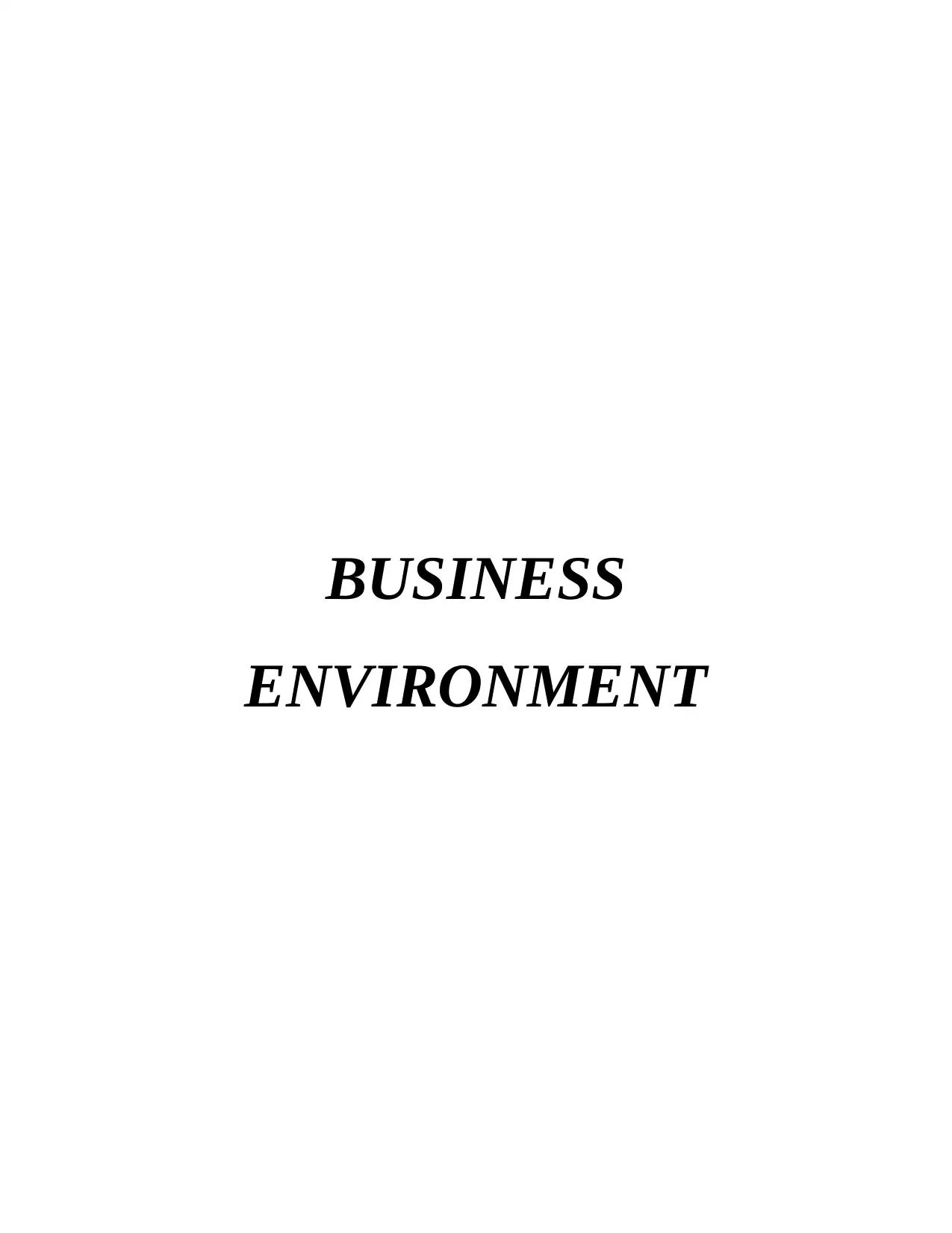
BUSINESS
ENVIRONMENT
ENVIRONMENT
Paraphrase This Document
Need a fresh take? Get an instant paraphrase of this document with our AI Paraphraser
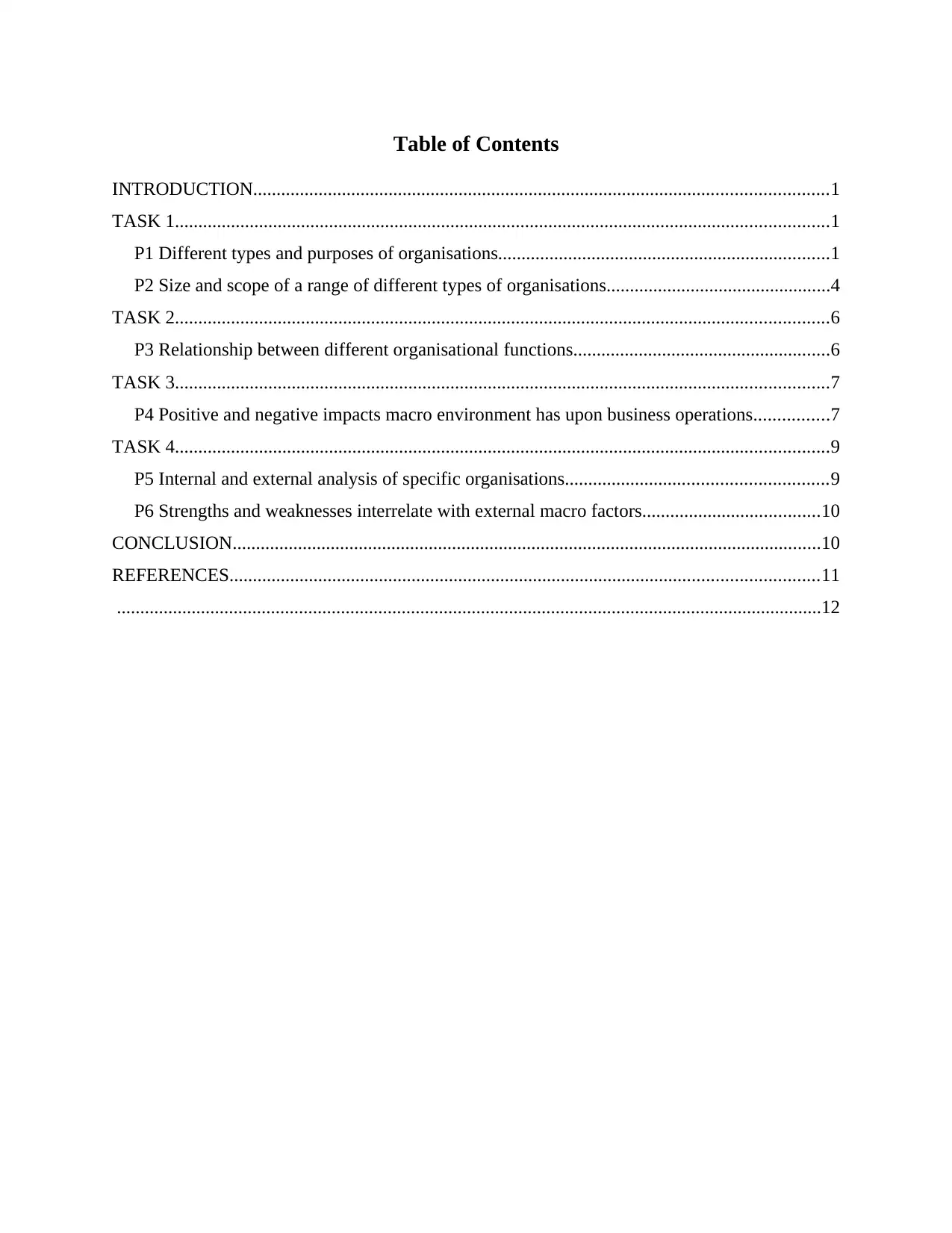
Table of Contents
INTRODUCTION...........................................................................................................................1
TASK 1............................................................................................................................................1
P1 Different types and purposes of organisations.......................................................................1
P2 Size and scope of a range of different types of organisations................................................4
TASK 2............................................................................................................................................6
P3 Relationship between different organisational functions.......................................................6
TASK 3............................................................................................................................................7
P4 Positive and negative impacts macro environment has upon business operations................7
TASK 4............................................................................................................................................9
P5 Internal and external analysis of specific organisations........................................................9
P6 Strengths and weaknesses interrelate with external macro factors......................................10
CONCLUSION..............................................................................................................................10
REFERENCES..............................................................................................................................11
.......................................................................................................................................................12
INTRODUCTION...........................................................................................................................1
TASK 1............................................................................................................................................1
P1 Different types and purposes of organisations.......................................................................1
P2 Size and scope of a range of different types of organisations................................................4
TASK 2............................................................................................................................................6
P3 Relationship between different organisational functions.......................................................6
TASK 3............................................................................................................................................7
P4 Positive and negative impacts macro environment has upon business operations................7
TASK 4............................................................................................................................................9
P5 Internal and external analysis of specific organisations........................................................9
P6 Strengths and weaknesses interrelate with external macro factors......................................10
CONCLUSION..............................................................................................................................10
REFERENCES..............................................................................................................................11
.......................................................................................................................................................12
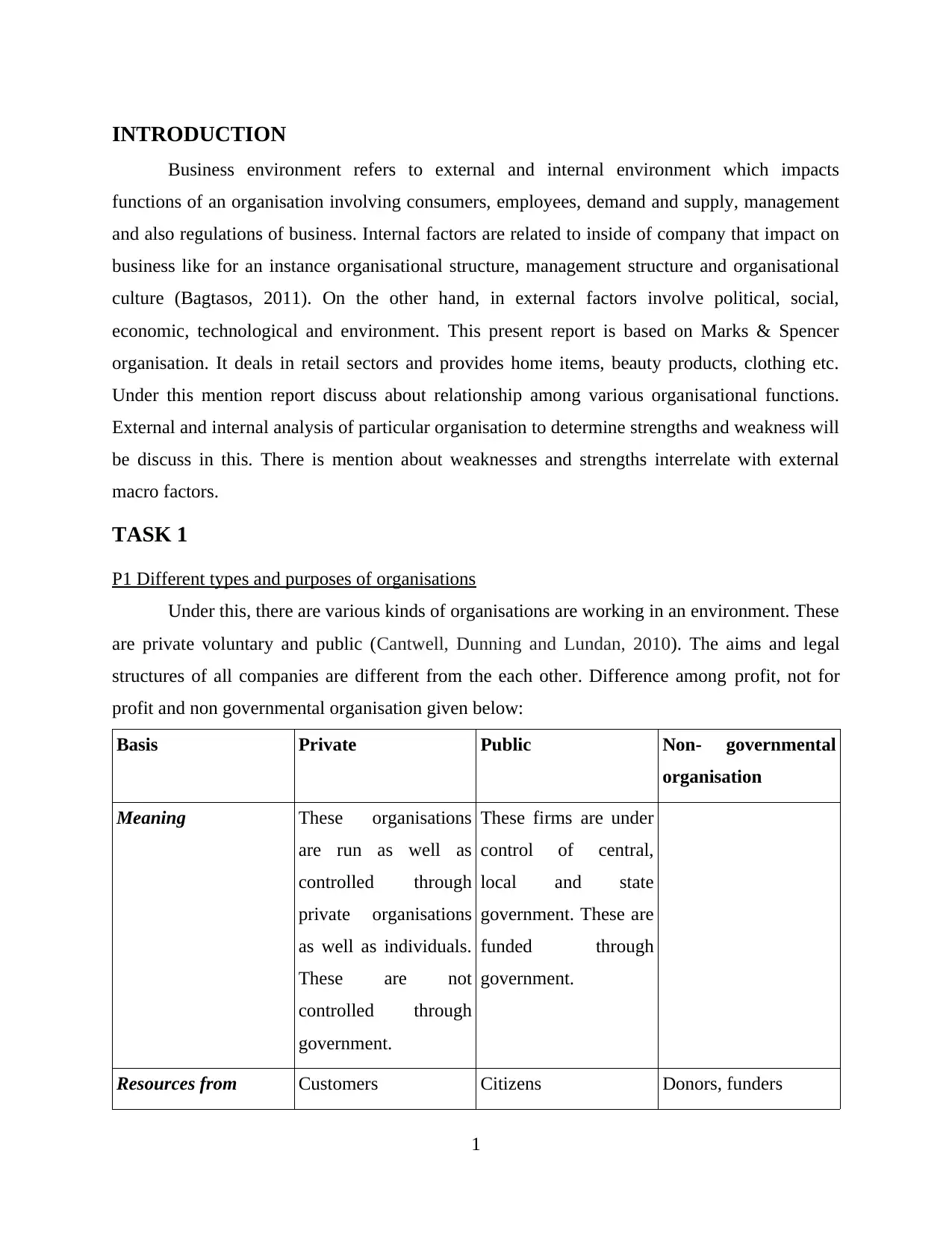
INTRODUCTION
Business environment refers to external and internal environment which impacts
functions of an organisation involving consumers, employees, demand and supply, management
and also regulations of business. Internal factors are related to inside of company that impact on
business like for an instance organisational structure, management structure and organisational
culture (Bagtasos, 2011). On the other hand, in external factors involve political, social,
economic, technological and environment. This present report is based on Marks & Spencer
organisation. It deals in retail sectors and provides home items, beauty products, clothing etc.
Under this mention report discuss about relationship among various organisational functions.
External and internal analysis of particular organisation to determine strengths and weakness will
be discuss in this. There is mention about weaknesses and strengths interrelate with external
macro factors.
TASK 1
P1 Different types and purposes of organisations
Under this, there are various kinds of organisations are working in an environment. These
are private voluntary and public (Cantwell, Dunning and Lundan, 2010). The aims and legal
structures of all companies are different from the each other. Difference among profit, not for
profit and non governmental organisation given below:
Basis Private Public Non- governmental
organisation
Meaning These organisations
are run as well as
controlled through
private organisations
as well as individuals.
These are not
controlled through
government.
These firms are under
control of central,
local and state
government. These are
funded through
government.
Resources from Customers Citizens Donors, funders
1
Business environment refers to external and internal environment which impacts
functions of an organisation involving consumers, employees, demand and supply, management
and also regulations of business. Internal factors are related to inside of company that impact on
business like for an instance organisational structure, management structure and organisational
culture (Bagtasos, 2011). On the other hand, in external factors involve political, social,
economic, technological and environment. This present report is based on Marks & Spencer
organisation. It deals in retail sectors and provides home items, beauty products, clothing etc.
Under this mention report discuss about relationship among various organisational functions.
External and internal analysis of particular organisation to determine strengths and weakness will
be discuss in this. There is mention about weaknesses and strengths interrelate with external
macro factors.
TASK 1
P1 Different types and purposes of organisations
Under this, there are various kinds of organisations are working in an environment. These
are private voluntary and public (Cantwell, Dunning and Lundan, 2010). The aims and legal
structures of all companies are different from the each other. Difference among profit, not for
profit and non governmental organisation given below:
Basis Private Public Non- governmental
organisation
Meaning These organisations
are run as well as
controlled through
private organisations
as well as individuals.
These are not
controlled through
government.
These firms are under
control of central,
local and state
government. These are
funded through
government.
Resources from Customers Citizens Donors, funders
1
⊘ This is a preview!⊘
Do you want full access?
Subscribe today to unlock all pages.

Trusted by 1+ million students worldwide
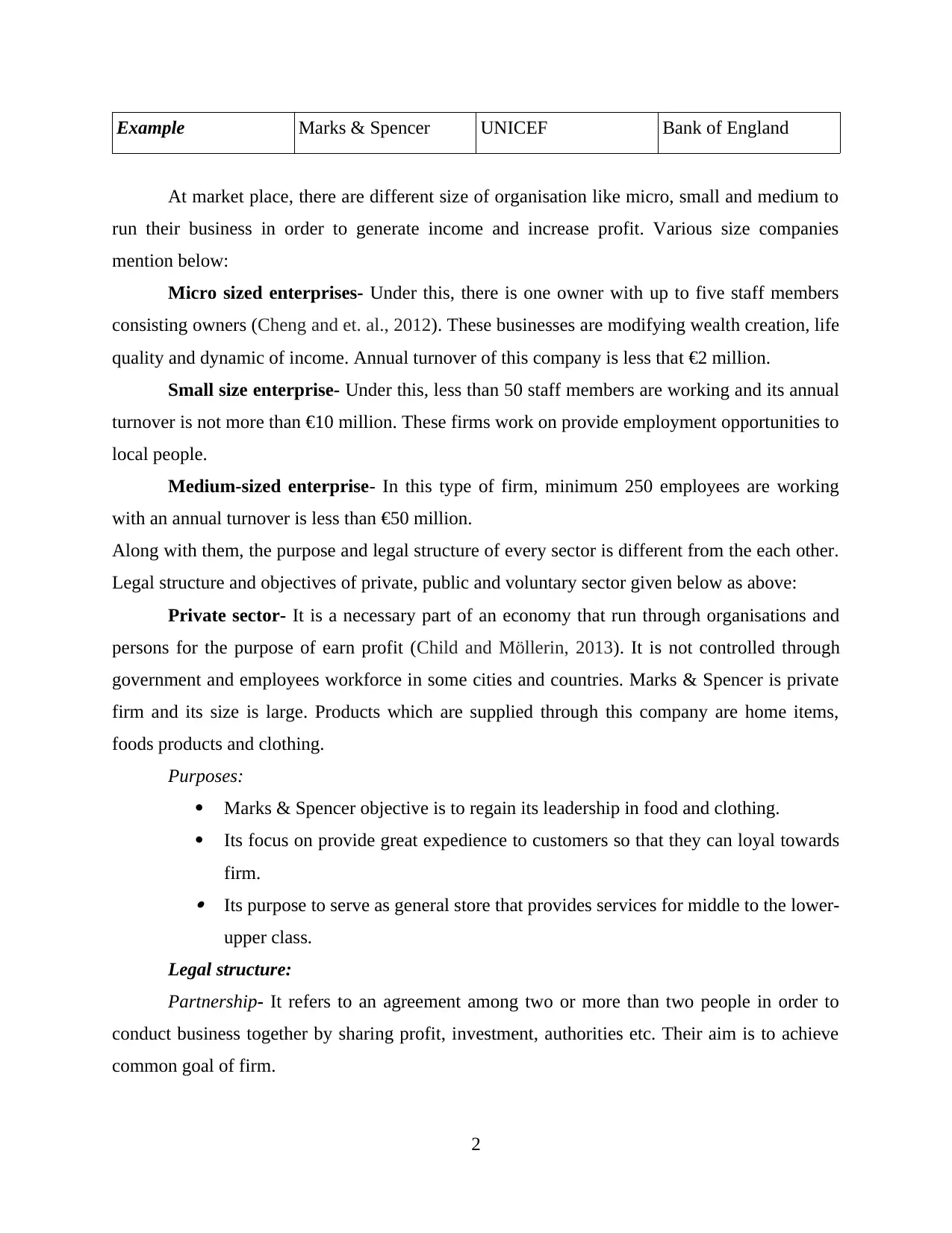
Example Marks & Spencer UNICEF Bank of England
At market place, there are different size of organisation like micro, small and medium to
run their business in order to generate income and increase profit. Various size companies
mention below:
Micro sized enterprises- Under this, there is one owner with up to five staff members
consisting owners (Cheng and et. al., 2012). These businesses are modifying wealth creation, life
quality and dynamic of income. Annual turnover of this company is less that €2 million.
Small size enterprise- Under this, less than 50 staff members are working and its annual
turnover is not more than €10 million. These firms work on provide employment opportunities to
local people.
Medium-sized enterprise- In this type of firm, minimum 250 employees are working
with an annual turnover is less than €50 million.
Along with them, the purpose and legal structure of every sector is different from the each other.
Legal structure and objectives of private, public and voluntary sector given below as above:
Private sector- It is a necessary part of an economy that run through organisations and
persons for the purpose of earn profit (Child and Möllerin, 2013). It is not controlled through
government and employees workforce in some cities and countries. Marks & Spencer is private
firm and its size is large. Products which are supplied through this company are home items,
foods products and clothing.
Purposes:
Marks & Spencer objective is to regain its leadership in food and clothing.
Its focus on provide great expedience to customers so that they can loyal towards
firm.
Its purpose to serve as general store that provides services for middle to the lower-
upper class.
Legal structure:
Partnership- It refers to an agreement among two or more than two people in order to
conduct business together by sharing profit, investment, authorities etc. Their aim is to achieve
common goal of firm.
2
At market place, there are different size of organisation like micro, small and medium to
run their business in order to generate income and increase profit. Various size companies
mention below:
Micro sized enterprises- Under this, there is one owner with up to five staff members
consisting owners (Cheng and et. al., 2012). These businesses are modifying wealth creation, life
quality and dynamic of income. Annual turnover of this company is less that €2 million.
Small size enterprise- Under this, less than 50 staff members are working and its annual
turnover is not more than €10 million. These firms work on provide employment opportunities to
local people.
Medium-sized enterprise- In this type of firm, minimum 250 employees are working
with an annual turnover is less than €50 million.
Along with them, the purpose and legal structure of every sector is different from the each other.
Legal structure and objectives of private, public and voluntary sector given below as above:
Private sector- It is a necessary part of an economy that run through organisations and
persons for the purpose of earn profit (Child and Möllerin, 2013). It is not controlled through
government and employees workforce in some cities and countries. Marks & Spencer is private
firm and its size is large. Products which are supplied through this company are home items,
foods products and clothing.
Purposes:
Marks & Spencer objective is to regain its leadership in food and clothing.
Its focus on provide great expedience to customers so that they can loyal towards
firm.
Its purpose to serve as general store that provides services for middle to the lower-
upper class.
Legal structure:
Partnership- It refers to an agreement among two or more than two people in order to
conduct business together by sharing profit, investment, authorities etc. Their aim is to achieve
common goal of firm.
2
Paraphrase This Document
Need a fresh take? Get an instant paraphrase of this document with our AI Paraphraser
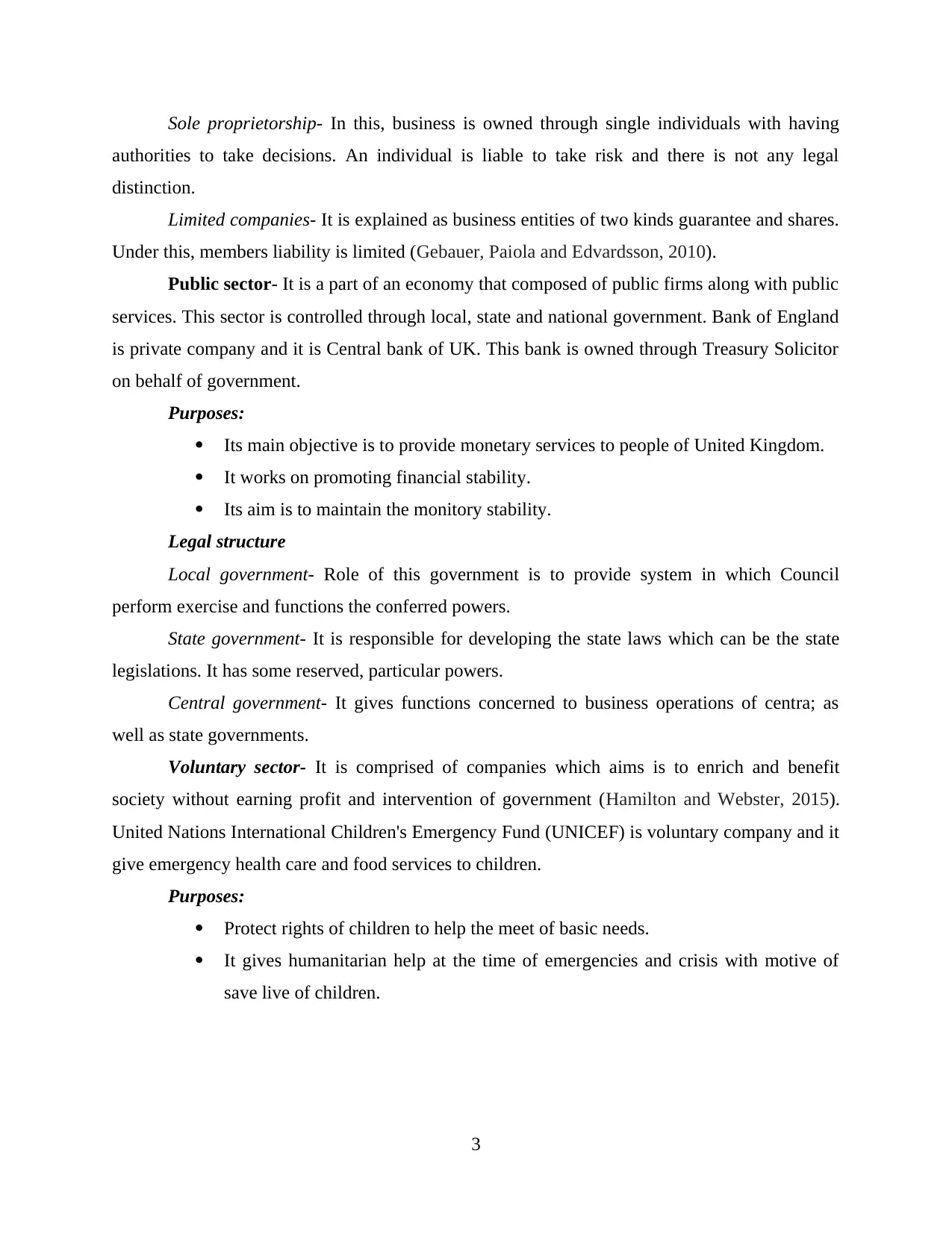
Sole proprietorship- In this, business is owned through single individuals with having
authorities to take decisions. An individual is liable to take risk and there is not any legal
distinction.
Limited companies- It is explained as business entities of two kinds guarantee and shares.
Under this, members liability is limited (Gebauer, Paiola and Edvardsson, 2010).
Public sector- It is a part of an economy that composed of public firms along with public
services. This sector is controlled through local, state and national government. Bank of England
is private company and it is Central bank of UK. This bank is owned through Treasury Solicitor
on behalf of government.
Purposes:
Its main objective is to provide monetary services to people of United Kingdom.
It works on promoting financial stability.
Its aim is to maintain the monitory stability.
Legal structure
Local government- Role of this government is to provide system in which Council
perform exercise and functions the conferred powers.
State government- It is responsible for developing the state laws which can be the state
legislations. It has some reserved, particular powers.
Central government- It gives functions concerned to business operations of centra; as
well as state governments.
Voluntary sector- It is comprised of companies which aims is to enrich and benefit
society without earning profit and intervention of government (Hamilton and Webster, 2015).
United Nations International Children's Emergency Fund (UNICEF) is voluntary company and it
give emergency health care and food services to children.
Purposes:
Protect rights of children to help the meet of basic needs.
It gives humanitarian help at the time of emergencies and crisis with motive of
save live of children.
3
authorities to take decisions. An individual is liable to take risk and there is not any legal
distinction.
Limited companies- It is explained as business entities of two kinds guarantee and shares.
Under this, members liability is limited (Gebauer, Paiola and Edvardsson, 2010).
Public sector- It is a part of an economy that composed of public firms along with public
services. This sector is controlled through local, state and national government. Bank of England
is private company and it is Central bank of UK. This bank is owned through Treasury Solicitor
on behalf of government.
Purposes:
Its main objective is to provide monetary services to people of United Kingdom.
It works on promoting financial stability.
Its aim is to maintain the monitory stability.
Legal structure
Local government- Role of this government is to provide system in which Council
perform exercise and functions the conferred powers.
State government- It is responsible for developing the state laws which can be the state
legislations. It has some reserved, particular powers.
Central government- It gives functions concerned to business operations of centra; as
well as state governments.
Voluntary sector- It is comprised of companies which aims is to enrich and benefit
society without earning profit and intervention of government (Hamilton and Webster, 2015).
United Nations International Children's Emergency Fund (UNICEF) is voluntary company and it
give emergency health care and food services to children.
Purposes:
Protect rights of children to help the meet of basic needs.
It gives humanitarian help at the time of emergencies and crisis with motive of
save live of children.
3
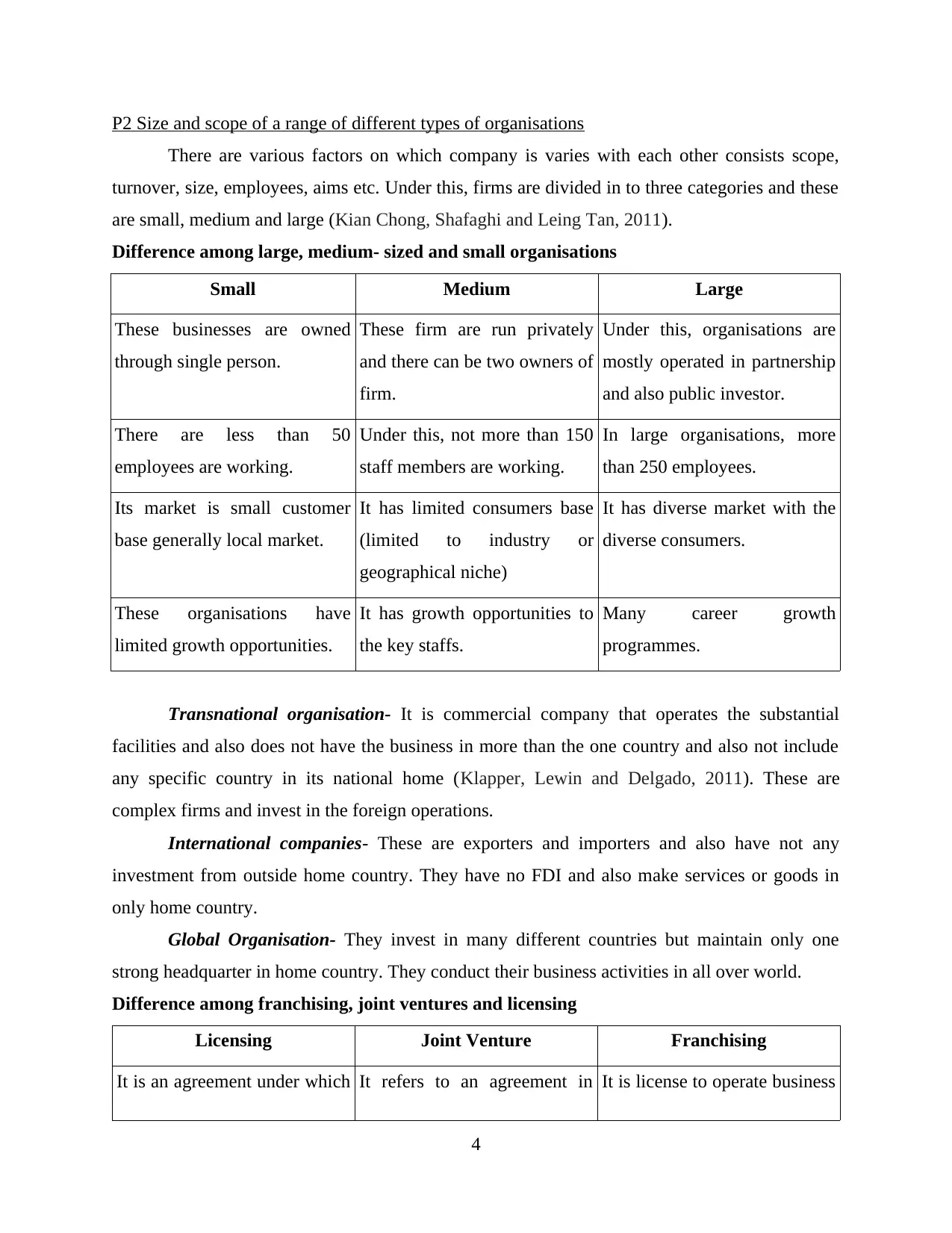
P2 Size and scope of a range of different types of organisations
There are various factors on which company is varies with each other consists scope,
turnover, size, employees, aims etc. Under this, firms are divided in to three categories and these
are small, medium and large (Kian Chong, Shafaghi and Leing Tan, 2011).
Difference among large, medium- sized and small organisations
Small Medium Large
These businesses are owned
through single person.
These firm are run privately
and there can be two owners of
firm.
Under this, organisations are
mostly operated in partnership
and also public investor.
There are less than 50
employees are working.
Under this, not more than 150
staff members are working.
In large organisations, more
than 250 employees.
Its market is small customer
base generally local market.
It has limited consumers base
(limited to industry or
geographical niche)
It has diverse market with the
diverse consumers.
These organisations have
limited growth opportunities.
It has growth opportunities to
the key staffs.
Many career growth
programmes.
Transnational organisation- It is commercial company that operates the substantial
facilities and also does not have the business in more than the one country and also not include
any specific country in its national home (Klapper, Lewin and Delgado, 2011). These are
complex firms and invest in the foreign operations.
International companies- These are exporters and importers and also have not any
investment from outside home country. They have no FDI and also make services or goods in
only home country.
Global Organisation- They invest in many different countries but maintain only one
strong headquarter in home country. They conduct their business activities in all over world.
Difference among franchising, joint ventures and licensing
Licensing Joint Venture Franchising
It is an agreement under which It refers to an agreement in It is license to operate business
4
There are various factors on which company is varies with each other consists scope,
turnover, size, employees, aims etc. Under this, firms are divided in to three categories and these
are small, medium and large (Kian Chong, Shafaghi and Leing Tan, 2011).
Difference among large, medium- sized and small organisations
Small Medium Large
These businesses are owned
through single person.
These firm are run privately
and there can be two owners of
firm.
Under this, organisations are
mostly operated in partnership
and also public investor.
There are less than 50
employees are working.
Under this, not more than 150
staff members are working.
In large organisations, more
than 250 employees.
Its market is small customer
base generally local market.
It has limited consumers base
(limited to industry or
geographical niche)
It has diverse market with the
diverse consumers.
These organisations have
limited growth opportunities.
It has growth opportunities to
the key staffs.
Many career growth
programmes.
Transnational organisation- It is commercial company that operates the substantial
facilities and also does not have the business in more than the one country and also not include
any specific country in its national home (Klapper, Lewin and Delgado, 2011). These are
complex firms and invest in the foreign operations.
International companies- These are exporters and importers and also have not any
investment from outside home country. They have no FDI and also make services or goods in
only home country.
Global Organisation- They invest in many different countries but maintain only one
strong headquarter in home country. They conduct their business activities in all over world.
Difference among franchising, joint ventures and licensing
Licensing Joint Venture Franchising
It is an agreement under which It refers to an agreement in It is license to operate business
4
⊘ This is a preview!⊘
Do you want full access?
Subscribe today to unlock all pages.

Trusted by 1+ million students worldwide
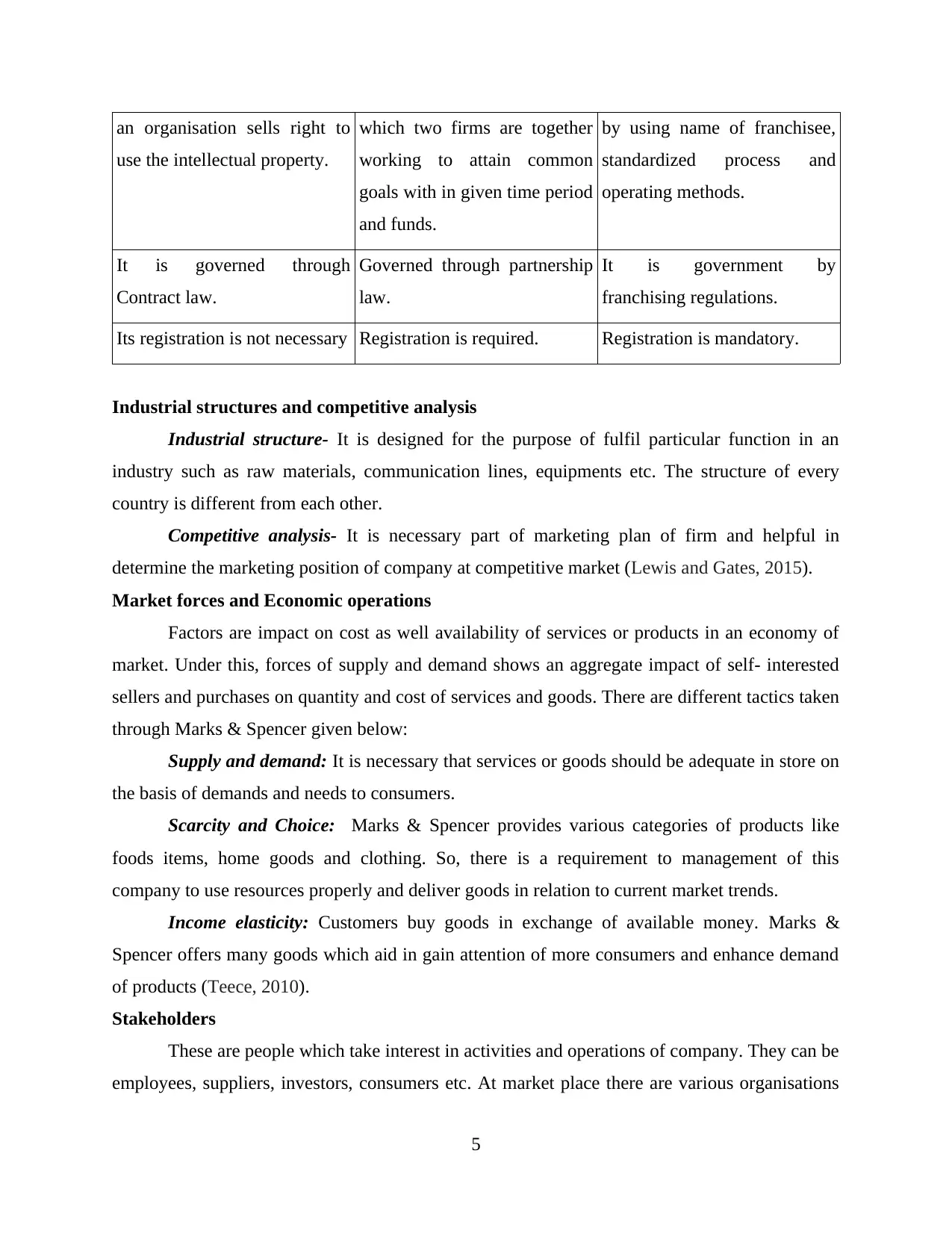
an organisation sells right to
use the intellectual property.
which two firms are together
working to attain common
goals with in given time period
and funds.
by using name of franchisee,
standardized process and
operating methods.
It is governed through
Contract law.
Governed through partnership
law.
It is government by
franchising regulations.
Its registration is not necessary Registration is required. Registration is mandatory.
Industrial structures and competitive analysis
Industrial structure- It is designed for the purpose of fulfil particular function in an
industry such as raw materials, communication lines, equipments etc. The structure of every
country is different from each other.
Competitive analysis- It is necessary part of marketing plan of firm and helpful in
determine the marketing position of company at competitive market (Lewis and Gates, 2015).
Market forces and Economic operations
Factors are impact on cost as well availability of services or products in an economy of
market. Under this, forces of supply and demand shows an aggregate impact of self- interested
sellers and purchases on quantity and cost of services and goods. There are different tactics taken
through Marks & Spencer given below:
Supply and demand: It is necessary that services or goods should be adequate in store on
the basis of demands and needs to consumers.
Scarcity and Choice: Marks & Spencer provides various categories of products like
foods items, home goods and clothing. So, there is a requirement to management of this
company to use resources properly and deliver goods in relation to current market trends.
Income elasticity: Customers buy goods in exchange of available money. Marks &
Spencer offers many goods which aid in gain attention of more consumers and enhance demand
of products (Teece, 2010).
Stakeholders
These are people which take interest in activities and operations of company. They can be
employees, suppliers, investors, consumers etc. At market place there are various organisations
5
use the intellectual property.
which two firms are together
working to attain common
goals with in given time period
and funds.
by using name of franchisee,
standardized process and
operating methods.
It is governed through
Contract law.
Governed through partnership
law.
It is government by
franchising regulations.
Its registration is not necessary Registration is required. Registration is mandatory.
Industrial structures and competitive analysis
Industrial structure- It is designed for the purpose of fulfil particular function in an
industry such as raw materials, communication lines, equipments etc. The structure of every
country is different from each other.
Competitive analysis- It is necessary part of marketing plan of firm and helpful in
determine the marketing position of company at competitive market (Lewis and Gates, 2015).
Market forces and Economic operations
Factors are impact on cost as well availability of services or products in an economy of
market. Under this, forces of supply and demand shows an aggregate impact of self- interested
sellers and purchases on quantity and cost of services and goods. There are different tactics taken
through Marks & Spencer given below:
Supply and demand: It is necessary that services or goods should be adequate in store on
the basis of demands and needs to consumers.
Scarcity and Choice: Marks & Spencer provides various categories of products like
foods items, home goods and clothing. So, there is a requirement to management of this
company to use resources properly and deliver goods in relation to current market trends.
Income elasticity: Customers buy goods in exchange of available money. Marks &
Spencer offers many goods which aid in gain attention of more consumers and enhance demand
of products (Teece, 2010).
Stakeholders
These are people which take interest in activities and operations of company. They can be
employees, suppliers, investors, consumers etc. At market place there are various organisations
5
Paraphrase This Document
Need a fresh take? Get an instant paraphrase of this document with our AI Paraphraser
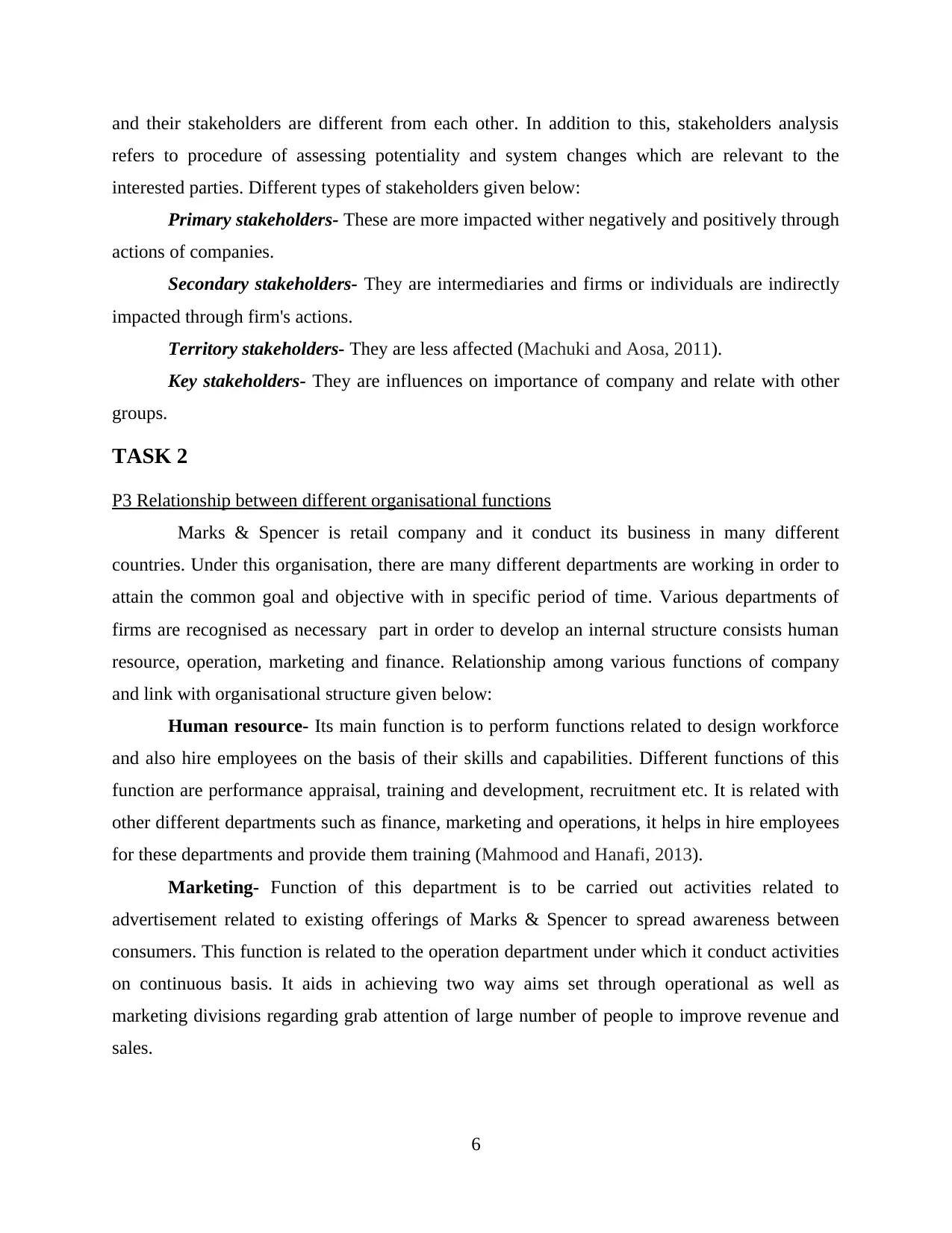
and their stakeholders are different from each other. In addition to this, stakeholders analysis
refers to procedure of assessing potentiality and system changes which are relevant to the
interested parties. Different types of stakeholders given below:
Primary stakeholders- These are more impacted wither negatively and positively through
actions of companies.
Secondary stakeholders- They are intermediaries and firms or individuals are indirectly
impacted through firm's actions.
Territory stakeholders- They are less affected (Machuki and Aosa, 2011).
Key stakeholders- They are influences on importance of company and relate with other
groups.
TASK 2
P3 Relationship between different organisational functions
Marks & Spencer is retail company and it conduct its business in many different
countries. Under this organisation, there are many different departments are working in order to
attain the common goal and objective with in specific period of time. Various departments of
firms are recognised as necessary part in order to develop an internal structure consists human
resource, operation, marketing and finance. Relationship among various functions of company
and link with organisational structure given below:
Human resource- Its main function is to perform functions related to design workforce
and also hire employees on the basis of their skills and capabilities. Different functions of this
function are performance appraisal, training and development, recruitment etc. It is related with
other different departments such as finance, marketing and operations, it helps in hire employees
for these departments and provide them training (Mahmood and Hanafi, 2013).
Marketing- Function of this department is to be carried out activities related to
advertisement related to existing offerings of Marks & Spencer to spread awareness between
consumers. This function is related to the operation department under which it conduct activities
on continuous basis. It aids in achieving two way aims set through operational as well as
marketing divisions regarding grab attention of large number of people to improve revenue and
sales.
6
refers to procedure of assessing potentiality and system changes which are relevant to the
interested parties. Different types of stakeholders given below:
Primary stakeholders- These are more impacted wither negatively and positively through
actions of companies.
Secondary stakeholders- They are intermediaries and firms or individuals are indirectly
impacted through firm's actions.
Territory stakeholders- They are less affected (Machuki and Aosa, 2011).
Key stakeholders- They are influences on importance of company and relate with other
groups.
TASK 2
P3 Relationship between different organisational functions
Marks & Spencer is retail company and it conduct its business in many different
countries. Under this organisation, there are many different departments are working in order to
attain the common goal and objective with in specific period of time. Various departments of
firms are recognised as necessary part in order to develop an internal structure consists human
resource, operation, marketing and finance. Relationship among various functions of company
and link with organisational structure given below:
Human resource- Its main function is to perform functions related to design workforce
and also hire employees on the basis of their skills and capabilities. Different functions of this
function are performance appraisal, training and development, recruitment etc. It is related with
other different departments such as finance, marketing and operations, it helps in hire employees
for these departments and provide them training (Mahmood and Hanafi, 2013).
Marketing- Function of this department is to be carried out activities related to
advertisement related to existing offerings of Marks & Spencer to spread awareness between
consumers. This function is related to the operation department under which it conduct activities
on continuous basis. It aids in achieving two way aims set through operational as well as
marketing divisions regarding grab attention of large number of people to improve revenue and
sales.
6
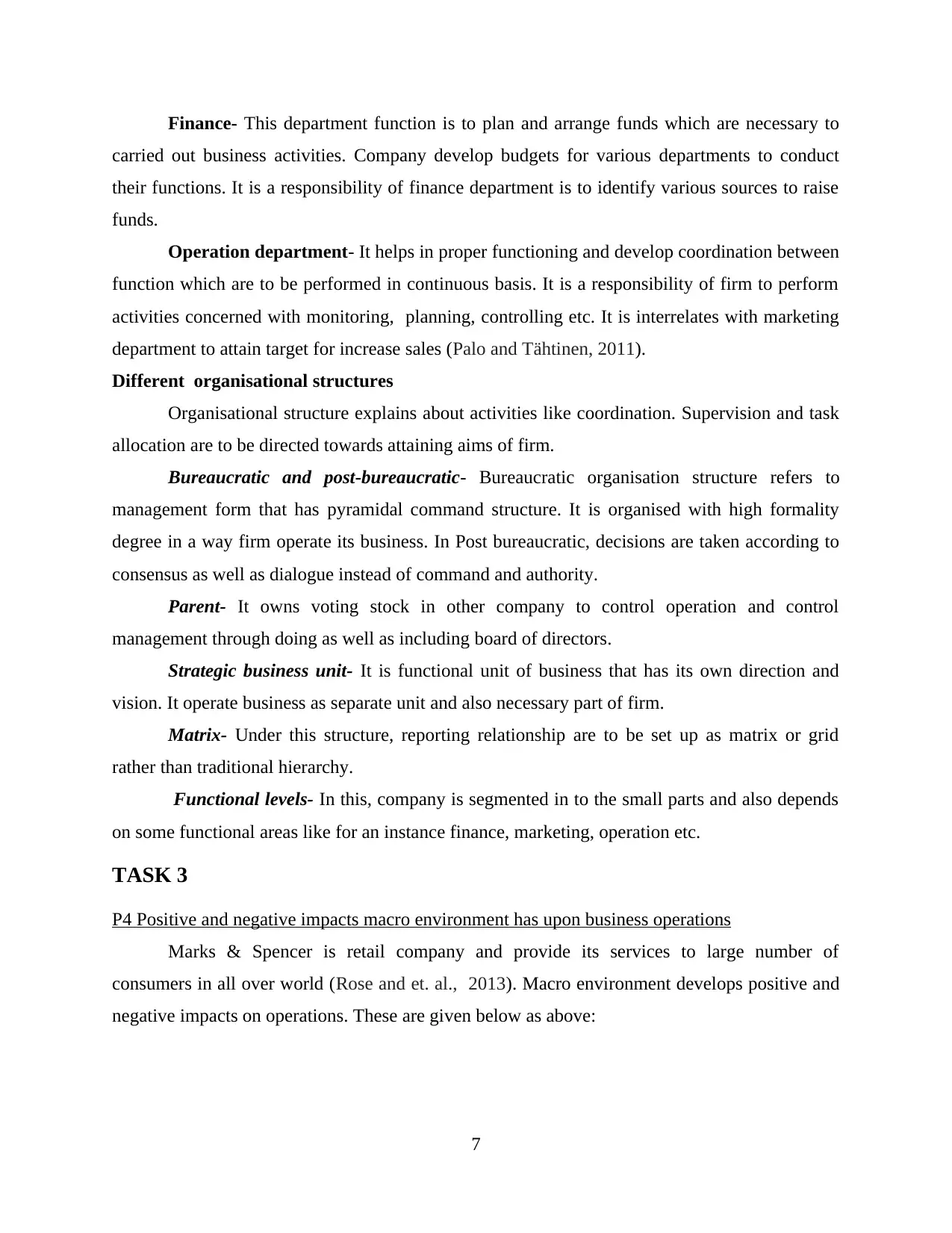
Finance- This department function is to plan and arrange funds which are necessary to
carried out business activities. Company develop budgets for various departments to conduct
their functions. It is a responsibility of finance department is to identify various sources to raise
funds.
Operation department- It helps in proper functioning and develop coordination between
function which are to be performed in continuous basis. It is a responsibility of firm to perform
activities concerned with monitoring, planning, controlling etc. It is interrelates with marketing
department to attain target for increase sales (Palo and Tähtinen, 2011).
Different organisational structures
Organisational structure explains about activities like coordination. Supervision and task
allocation are to be directed towards attaining aims of firm.
Bureaucratic and post-bureaucratic- Bureaucratic organisation structure refers to
management form that has pyramidal command structure. It is organised with high formality
degree in a way firm operate its business. In Post bureaucratic, decisions are taken according to
consensus as well as dialogue instead of command and authority.
Parent- It owns voting stock in other company to control operation and control
management through doing as well as including board of directors.
Strategic business unit- It is functional unit of business that has its own direction and
vision. It operate business as separate unit and also necessary part of firm.
Matrix- Under this structure, reporting relationship are to be set up as matrix or grid
rather than traditional hierarchy.
Functional levels- In this, company is segmented in to the small parts and also depends
on some functional areas like for an instance finance, marketing, operation etc.
TASK 3
P4 Positive and negative impacts macro environment has upon business operations
Marks & Spencer is retail company and provide its services to large number of
consumers in all over world (Rose and et. al., 2013). Macro environment develops positive and
negative impacts on operations. These are given below as above:
7
carried out business activities. Company develop budgets for various departments to conduct
their functions. It is a responsibility of finance department is to identify various sources to raise
funds.
Operation department- It helps in proper functioning and develop coordination between
function which are to be performed in continuous basis. It is a responsibility of firm to perform
activities concerned with monitoring, planning, controlling etc. It is interrelates with marketing
department to attain target for increase sales (Palo and Tähtinen, 2011).
Different organisational structures
Organisational structure explains about activities like coordination. Supervision and task
allocation are to be directed towards attaining aims of firm.
Bureaucratic and post-bureaucratic- Bureaucratic organisation structure refers to
management form that has pyramidal command structure. It is organised with high formality
degree in a way firm operate its business. In Post bureaucratic, decisions are taken according to
consensus as well as dialogue instead of command and authority.
Parent- It owns voting stock in other company to control operation and control
management through doing as well as including board of directors.
Strategic business unit- It is functional unit of business that has its own direction and
vision. It operate business as separate unit and also necessary part of firm.
Matrix- Under this structure, reporting relationship are to be set up as matrix or grid
rather than traditional hierarchy.
Functional levels- In this, company is segmented in to the small parts and also depends
on some functional areas like for an instance finance, marketing, operation etc.
TASK 3
P4 Positive and negative impacts macro environment has upon business operations
Marks & Spencer is retail company and provide its services to large number of
consumers in all over world (Rose and et. al., 2013). Macro environment develops positive and
negative impacts on operations. These are given below as above:
7
⊘ This is a preview!⊘
Do you want full access?
Subscribe today to unlock all pages.

Trusted by 1+ million students worldwide
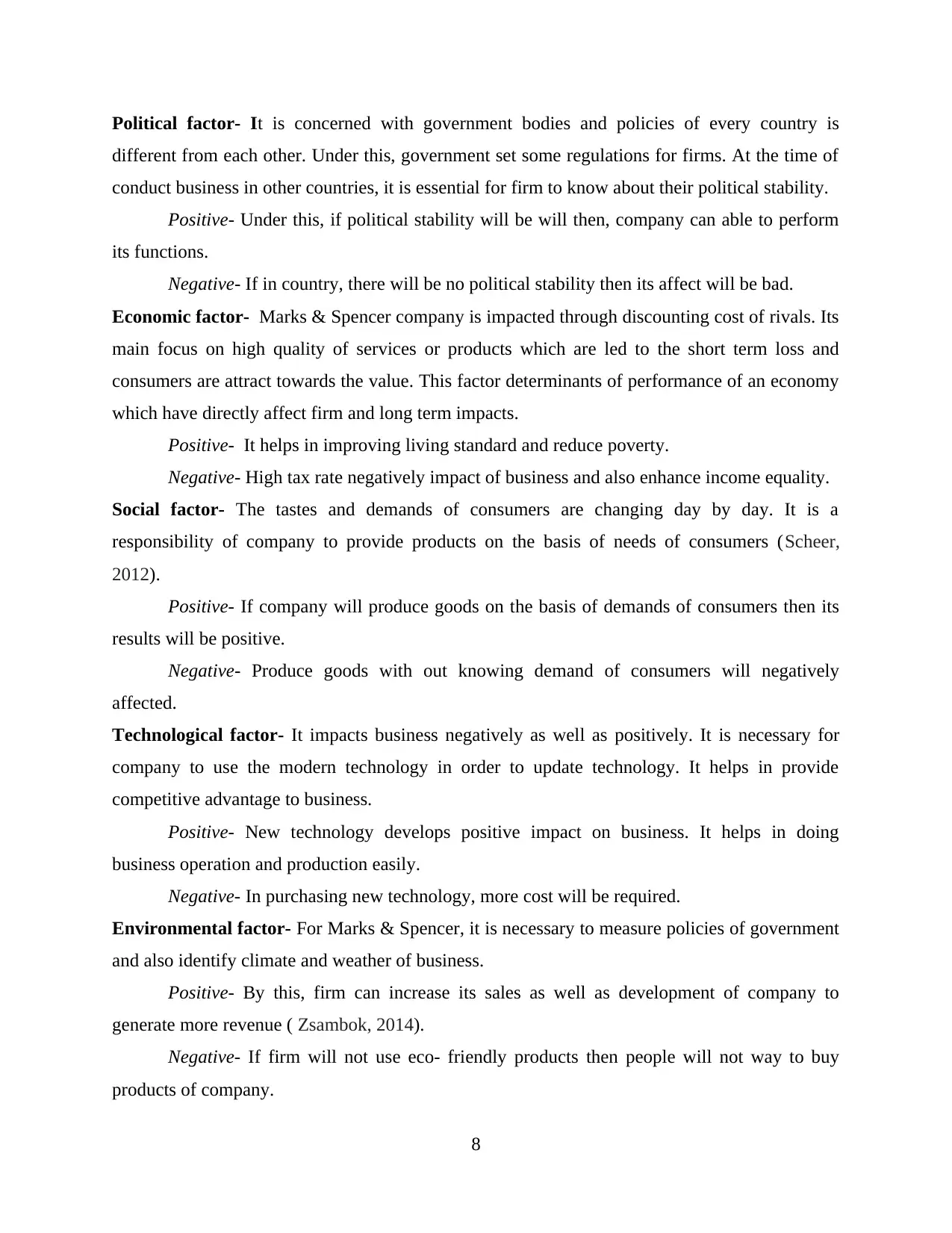
Political factor- It is concerned with government bodies and policies of every country is
different from each other. Under this, government set some regulations for firms. At the time of
conduct business in other countries, it is essential for firm to know about their political stability.
Positive- Under this, if political stability will be will then, company can able to perform
its functions.
Negative- If in country, there will be no political stability then its affect will be bad.
Economic factor- Marks & Spencer company is impacted through discounting cost of rivals. Its
main focus on high quality of services or products which are led to the short term loss and
consumers are attract towards the value. This factor determinants of performance of an economy
which have directly affect firm and long term impacts.
Positive- It helps in improving living standard and reduce poverty.
Negative- High tax rate negatively impact of business and also enhance income equality.
Social factor- The tastes and demands of consumers are changing day by day. It is a
responsibility of company to provide products on the basis of needs of consumers (Scheer,
2012).
Positive- If company will produce goods on the basis of demands of consumers then its
results will be positive.
Negative- Produce goods with out knowing demand of consumers will negatively
affected.
Technological factor- It impacts business negatively as well as positively. It is necessary for
company to use the modern technology in order to update technology. It helps in provide
competitive advantage to business.
Positive- New technology develops positive impact on business. It helps in doing
business operation and production easily.
Negative- In purchasing new technology, more cost will be required.
Environmental factor- For Marks & Spencer, it is necessary to measure policies of government
and also identify climate and weather of business.
Positive- By this, firm can increase its sales as well as development of company to
generate more revenue ( Zsambok, 2014).
Negative- If firm will not use eco- friendly products then people will not way to buy
products of company.
8
different from each other. Under this, government set some regulations for firms. At the time of
conduct business in other countries, it is essential for firm to know about their political stability.
Positive- Under this, if political stability will be will then, company can able to perform
its functions.
Negative- If in country, there will be no political stability then its affect will be bad.
Economic factor- Marks & Spencer company is impacted through discounting cost of rivals. Its
main focus on high quality of services or products which are led to the short term loss and
consumers are attract towards the value. This factor determinants of performance of an economy
which have directly affect firm and long term impacts.
Positive- It helps in improving living standard and reduce poverty.
Negative- High tax rate negatively impact of business and also enhance income equality.
Social factor- The tastes and demands of consumers are changing day by day. It is a
responsibility of company to provide products on the basis of needs of consumers (Scheer,
2012).
Positive- If company will produce goods on the basis of demands of consumers then its
results will be positive.
Negative- Produce goods with out knowing demand of consumers will negatively
affected.
Technological factor- It impacts business negatively as well as positively. It is necessary for
company to use the modern technology in order to update technology. It helps in provide
competitive advantage to business.
Positive- New technology develops positive impact on business. It helps in doing
business operation and production easily.
Negative- In purchasing new technology, more cost will be required.
Environmental factor- For Marks & Spencer, it is necessary to measure policies of government
and also identify climate and weather of business.
Positive- By this, firm can increase its sales as well as development of company to
generate more revenue ( Zsambok, 2014).
Negative- If firm will not use eco- friendly products then people will not way to buy
products of company.
8
Paraphrase This Document
Need a fresh take? Get an instant paraphrase of this document with our AI Paraphraser
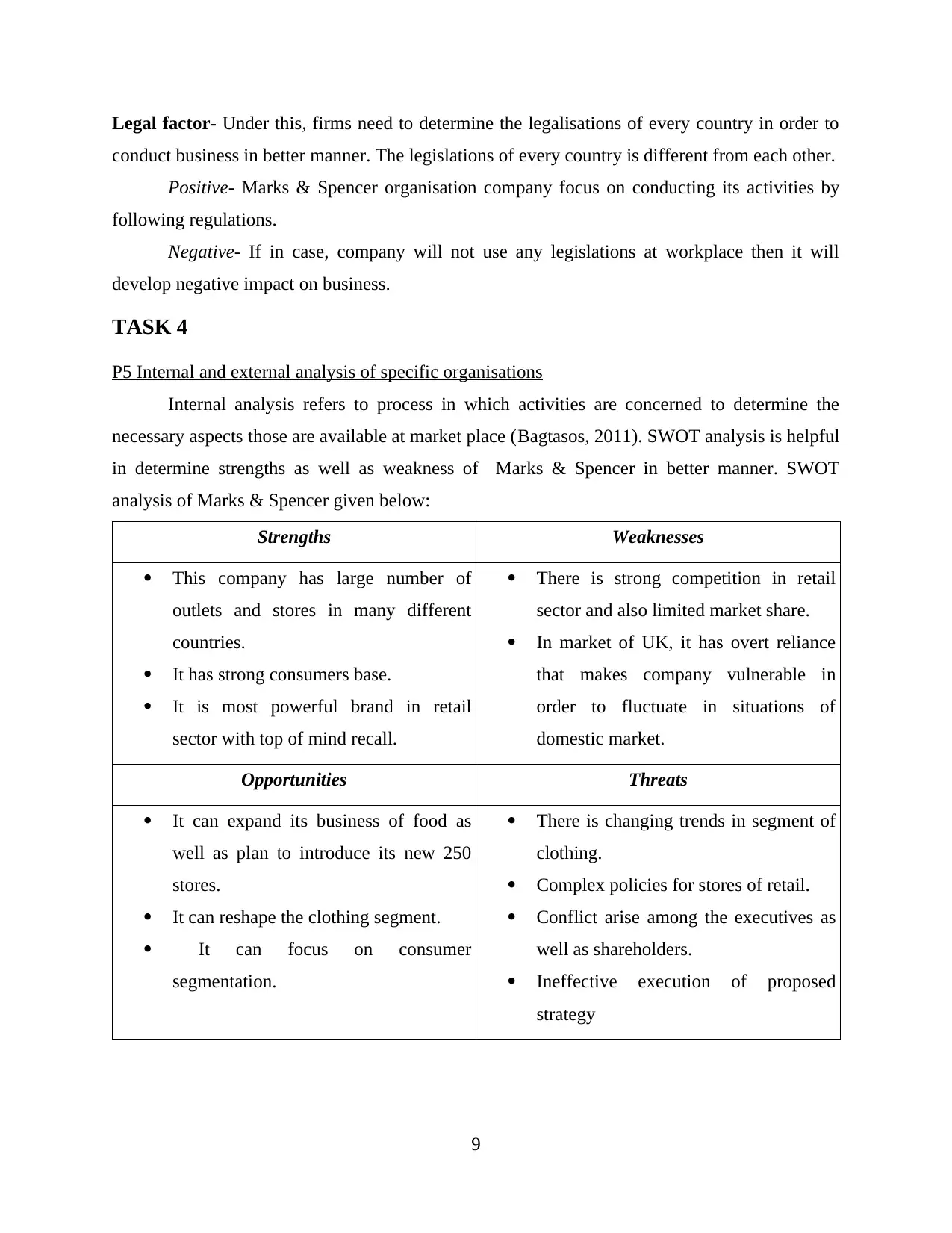
Legal factor- Under this, firms need to determine the legalisations of every country in order to
conduct business in better manner. The legislations of every country is different from each other.
Positive- Marks & Spencer organisation company focus on conducting its activities by
following regulations.
Negative- If in case, company will not use any legislations at workplace then it will
develop negative impact on business.
TASK 4
P5 Internal and external analysis of specific organisations
Internal analysis refers to process in which activities are concerned to determine the
necessary aspects those are available at market place (Bagtasos, 2011). SWOT analysis is helpful
in determine strengths as well as weakness of Marks & Spencer in better manner. SWOT
analysis of Marks & Spencer given below:
Strengths Weaknesses
This company has large number of
outlets and stores in many different
countries.
It has strong consumers base.
It is most powerful brand in retail
sector with top of mind recall.
There is strong competition in retail
sector and also limited market share.
In market of UK, it has overt reliance
that makes company vulnerable in
order to fluctuate in situations of
domestic market.
Opportunities Threats
It can expand its business of food as
well as plan to introduce its new 250
stores.
It can reshape the clothing segment.
It can focus on consumer
segmentation.
There is changing trends in segment of
clothing.
Complex policies for stores of retail.
Conflict arise among the executives as
well as shareholders.
Ineffective execution of proposed
strategy
9
conduct business in better manner. The legislations of every country is different from each other.
Positive- Marks & Spencer organisation company focus on conducting its activities by
following regulations.
Negative- If in case, company will not use any legislations at workplace then it will
develop negative impact on business.
TASK 4
P5 Internal and external analysis of specific organisations
Internal analysis refers to process in which activities are concerned to determine the
necessary aspects those are available at market place (Bagtasos, 2011). SWOT analysis is helpful
in determine strengths as well as weakness of Marks & Spencer in better manner. SWOT
analysis of Marks & Spencer given below:
Strengths Weaknesses
This company has large number of
outlets and stores in many different
countries.
It has strong consumers base.
It is most powerful brand in retail
sector with top of mind recall.
There is strong competition in retail
sector and also limited market share.
In market of UK, it has overt reliance
that makes company vulnerable in
order to fluctuate in situations of
domestic market.
Opportunities Threats
It can expand its business of food as
well as plan to introduce its new 250
stores.
It can reshape the clothing segment.
It can focus on consumer
segmentation.
There is changing trends in segment of
clothing.
Complex policies for stores of retail.
Conflict arise among the executives as
well as shareholders.
Ineffective execution of proposed
strategy
9
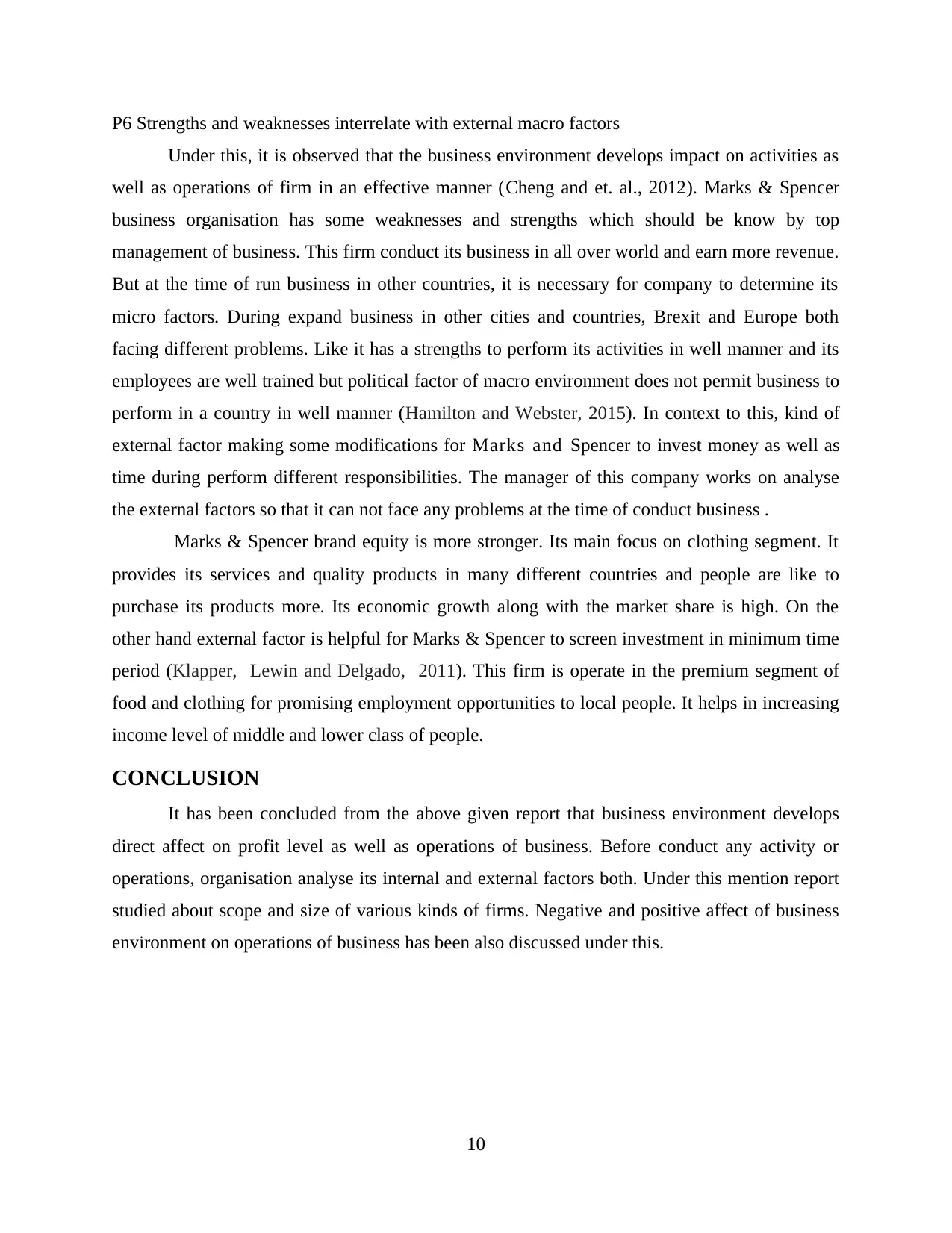
P6 Strengths and weaknesses interrelate with external macro factors
Under this, it is observed that the business environment develops impact on activities as
well as operations of firm in an effective manner (Cheng and et. al., 2012). Marks & Spencer
business organisation has some weaknesses and strengths which should be know by top
management of business. This firm conduct its business in all over world and earn more revenue.
But at the time of run business in other countries, it is necessary for company to determine its
micro factors. During expand business in other cities and countries, Brexit and Europe both
facing different problems. Like it has a strengths to perform its activities in well manner and its
employees are well trained but political factor of macro environment does not permit business to
perform in a country in well manner (Hamilton and Webster, 2015). In context to this, kind of
external factor making some modifications for Marks and Spencer to invest money as well as
time during perform different responsibilities. The manager of this company works on analyse
the external factors so that it can not face any problems at the time of conduct business .
Marks & Spencer brand equity is more stronger. Its main focus on clothing segment. It
provides its services and quality products in many different countries and people are like to
purchase its products more. Its economic growth along with the market share is high. On the
other hand external factor is helpful for Marks & Spencer to screen investment in minimum time
period (Klapper, Lewin and Delgado, 2011). This firm is operate in the premium segment of
food and clothing for promising employment opportunities to local people. It helps in increasing
income level of middle and lower class of people.
CONCLUSION
It has been concluded from the above given report that business environment develops
direct affect on profit level as well as operations of business. Before conduct any activity or
operations, organisation analyse its internal and external factors both. Under this mention report
studied about scope and size of various kinds of firms. Negative and positive affect of business
environment on operations of business has been also discussed under this.
10
Under this, it is observed that the business environment develops impact on activities as
well as operations of firm in an effective manner (Cheng and et. al., 2012). Marks & Spencer
business organisation has some weaknesses and strengths which should be know by top
management of business. This firm conduct its business in all over world and earn more revenue.
But at the time of run business in other countries, it is necessary for company to determine its
micro factors. During expand business in other cities and countries, Brexit and Europe both
facing different problems. Like it has a strengths to perform its activities in well manner and its
employees are well trained but political factor of macro environment does not permit business to
perform in a country in well manner (Hamilton and Webster, 2015). In context to this, kind of
external factor making some modifications for Marks and Spencer to invest money as well as
time during perform different responsibilities. The manager of this company works on analyse
the external factors so that it can not face any problems at the time of conduct business .
Marks & Spencer brand equity is more stronger. Its main focus on clothing segment. It
provides its services and quality products in many different countries and people are like to
purchase its products more. Its economic growth along with the market share is high. On the
other hand external factor is helpful for Marks & Spencer to screen investment in minimum time
period (Klapper, Lewin and Delgado, 2011). This firm is operate in the premium segment of
food and clothing for promising employment opportunities to local people. It helps in increasing
income level of middle and lower class of people.
CONCLUSION
It has been concluded from the above given report that business environment develops
direct affect on profit level as well as operations of business. Before conduct any activity or
operations, organisation analyse its internal and external factors both. Under this mention report
studied about scope and size of various kinds of firms. Negative and positive affect of business
environment on operations of business has been also discussed under this.
10
⊘ This is a preview!⊘
Do you want full access?
Subscribe today to unlock all pages.

Trusted by 1+ million students worldwide
1 out of 14
Related Documents
Your All-in-One AI-Powered Toolkit for Academic Success.
+13062052269
info@desklib.com
Available 24*7 on WhatsApp / Email
![[object Object]](/_next/static/media/star-bottom.7253800d.svg)
Unlock your academic potential
Copyright © 2020–2025 A2Z Services. All Rights Reserved. Developed and managed by ZUCOL.





